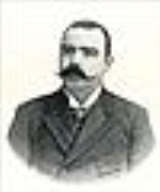
António Teixeira de Sousa
Encyclopedia
António Teixeira de Sousa, 2nd Count of Sousa Palmela (Celeirós
, Sabrosa
, 5 May 1857 - Celeirós, Sabrosa, 5 June 1917; ɐ̃ˈtɔniu tɐjˈʃɐjɾɐ dɨ ˈsowzɐ) was a Portuguese
medical doctor and politician during the Constitutional Monarchy
. He graduated in Medicine at the University of Porto
, in 1883.
A member of the conservative Regenerator Party, he was first elected to the Chamber of Deputies
, in 1889. He was later minister of the Navy and Overseas (1900–1903), and, twice, of Finance (1903–1904, 1906). He became President of the Council of Ministers (Prime Minister) on 26 June 1910, and would be the last Prime Minister of the Constitutional Monarchy as King D. Manuel II
was overthrowned by a republican revolution on October 5, 1910. He left politics after the republic proclamation, but showed a moderate support for the new regime
.
Celeirós
-Portugal:* Celeirós , a civil parish in the municipality of Braga* Celeirós , a civil parish in the municipality of Sabrosa...
, Sabrosa
Sabrosa
Sabrosa is a municipality in the district of Vila Real in northern Portugal. The municipality is composed of 15 parishes and has a total area of 156.92 km² and a population of 6,835 inhabitants .-History:Although the municipality was established on 6 November 1836, the history of the region...
, 5 May 1857 - Celeirós, Sabrosa, 5 June 1917; ɐ̃ˈtɔniu tɐjˈʃɐjɾɐ dɨ ˈsowzɐ) was a Portuguese
Portuguese people
The Portuguese are a nation and ethnic group native to the country of Portugal, in the west of the Iberian peninsula of south-west Europe. Their language is Portuguese, and Roman Catholicism is the predominant religion....
medical doctor and politician during the Constitutional Monarchy
History of Portugal (1834-1910)
The history of Portugal from the end of the Liberal Civil War in 1834 to the republican revolution of 1910 was marked by several events that made way for the proclamation of the Portuguese Republic in the 5 October 1910 revolution....
. He graduated in Medicine at the University of Porto
University of Porto
The University of Porto is a Portuguese public university located in Porto, and founded 22 March 1911. It is the largest Portuguese university by number of enrolled students and has one of the most noted research outputs in Portugal...
, in 1883.
A member of the conservative Regenerator Party, he was first elected to the Chamber of Deputies
Assembly of the Republic
The Assembly of the Republic is the Portuguese parliament. It is located in a historical building in Lisbon, referred to as Palácio de São Bento, the site of an old Benedictine monastery...
, in 1889. He was later minister of the Navy and Overseas (1900–1903), and, twice, of Finance (1903–1904, 1906). He became President of the Council of Ministers (Prime Minister) on 26 June 1910, and would be the last Prime Minister of the Constitutional Monarchy as King D. Manuel II
Manuel II of Portugal
Manuel II , named Manuel Maria Filipe Carlos Amélio Luís Miguel Rafael Gabriel Gonzaga Francisco de Assis Eugénio de Bragança Orleães Sabóia e Saxe-Coburgo-Gotha — , was the last King of Portugal from 1908 to 1910, ascending the throne after the assassination of his father and elder brother Manuel...
was overthrowned by a republican revolution on October 5, 1910. He left politics after the republic proclamation, but showed a moderate support for the new regime
Portuguese First Republic
The Portuguese First Republic spans a complex 16 year period in the history of Portugal, between the end of the period of constitutional monarchy marked by the 5 October 1910 revolution and the 28 May coup d'état of 1926...
.

